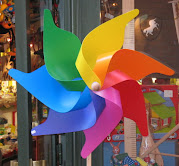
I've always been interested in art depicting Christ's baptism. Partly as a result of Charles Brock's creative teaching of the theology, symbolism and meaning of baptism by using a copy of Pierro della Francesco's Baptism of Christ. If I'm travelling through Trafalgar Sqaure in London I always try to make time to go and see the original which is in the National Gallery.
If you look carefully at della Franceso's painting you can see that although Christ is being baptised in the Jordan he is somehow standing on dry land in the middle of the river. Perhaps this symbolises the link with the children of Israel crossing the red sea on dry land and also crossing the Jordan on dry land. The river is in the shape of a serpent with Christ symbolically trampling down evil, it seems also to flow out of the side of a building in the distance, like the waters of life in Ezekiel 37. Perhaps the tree where the strange angelic figures with the transluscent wings are standing is a reference to the tree of life in Revelation 21 and of course there's much more to find and muse upon in the painting. Having bored countless confirmation classes with theses details there was no chance I was going to miss an opportunity to do the same here!
Anyway credit where credit is due, I discovered the national gallery online paintings thanks to Deirdre Good's wonderful and award-winning blog On not being a Sausage.
Sunday, 13 January 2008
The Baptism of Christ
Subscribe to:
Post Comments (Atom)






2 Comments:
Jane,
Thanks for the visual stimuli showing the Baptism of Jesus from the National Gallery. I also appreciated the previous post on the Magi (from a colleague of yours at the WCC I believe) making some telling points the liturgical calendar obscures.
Manoj is a great guy, a medical doctor who runs the HIV/AIDS programme at the WCC. He's also a great artist and a lay theologian - a real pleasure to work with.
Post a Comment